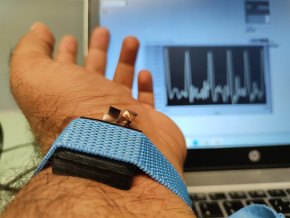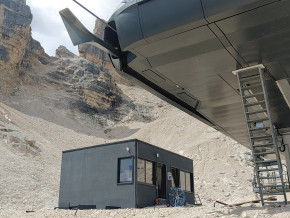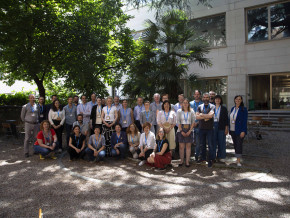Illuminating Numbers
Omar Lakkis, mathematician and unibz professor at the Faculty for Computer Science, loves to play around with numbers. His algorithms are at the heart of complex mirror arrays that create images by reflecting different intensities of light, allowing technicians and designers to develop sophisticated illumination systems.
When did you realise you had a passion for numbers?
Lakkis: It was later in life when I started studying engineering in Trieste. At that time, the first year of studies was dedicated to mathematics—I suppose to find out who were the really committed students. Rather than discouraging me from mathematics, in fact, I realised how much I love to play with numbers. One year later, I switched my courses over to straight math.
And how are you playing with numbers these days?
Lakkis: I am studying a computational model that shows how to position reflectors to “rearrange” light in an arbitrary way.
Perhaps we can understand this with an example? Have you heard of the small valley town of Viganella in the Piemonte? Up until 2006, the mountains blocked the sun from the valley for 80 days in the wintertime. Then an architect had a novel idea to use a giant mirror to reflect the sunlight into the valley.
Lakkis: This is a wonderful example. The giant mirror in Viganella is controlled by a computer software that tells the mirror to follow the sun. Now let’s suppose we want to illuminate only certain parts of this same village, like the main piazza. The bakery, on the other hand, needs to stay cool because it is already heated by artificial sources. This is where my math comes into play: I calculate how to curve a mirror, or position many flat mirrors, each with a different orientation, so as to reflect light with different intensities.

That doesn’t sound too complicated.
Lakkis: It sounds easy, but, like with many physics problems, when you start working on a solution you realize the complexity of it. Consider that to focus a flat source of light like the sun onto a single point, one needs a parabolic mirror. Our aim is to replace the single point by an arbitrary shape. What I do is approximate shapes and objects. Look at a football, for example. It appears round, but is actually made of many flat surfaces, such as hexagons, quadrilaterals, triangles and so on. My math connects those tiny little shapes with smooth “ideal” surfaces that would otherwise be much harder to design algorithmically and produce.
You’ve also been studying light as an optimal mean of transportation.
Lakkis: We think of light as “lazy” since it always travels the shortest distance from point A to point B. Light follows the path of ‘optimal transport’. There’s an equation to calculate this optimal transport path— the Monge-Ampère equation—and a transformation of the solution reveals the shape of the mirror. But this equation is generally very hard to solve. In a nutshell, I tell computers how to find the optimal transport path of, for example, the information contained in an image, and thereby the shape of the curved mirror.
I don’t quite get this.
Lakkis: Let’s say I take a black and white picture of Ötzi the ice mummy and put it on the computer. What would you see?
Different shades of grey…
Lakkis: … which can also be defined as different intensities of light. Now here’s my question: what shape of mirror will produce that exact same picture of Ötzi on a surface by reflecting light with different intensities? My job is to provide a computational model that can calculate this type of information transportation. Then in a second step, with the help of unibz designers and technicians, I will be able to put my calculations into a very concrete application.

What would this transport of image by light be useful for?
Lakkis: Computational models can be very useful in the car industry. They can help develop road-side reflectors that fade smoothly into the background and prevent tunnel vision. They can also be used to develop illumination systems for cities at night. All this makes for exciting computational challenges, and their mathematical analysis is even more exciting.
Born in Byblos (Lebanon), Omar Lakkis is a computational mathematician specialised in developing and analysing algorithms that approximate physical processes such as heat, fluids, waves and light. He has a Masters in Mathematics from Trieste and a PhD from Maryland. He worked in Milano, Crete and Sussex before moving to unibz. He enjoys the outdoors, cycling, cooking, baking, and travelling.
Related Articles

Tecno-prodotti. Creati nuovi sensori triboelettrici nel laboratorio di sensoristica al NOI Techpark
I wearable sono dispositivi ormai imprescindibili nel settore sanitario e sportivo: un mercato in crescita a livello globale che ha bisogno di fonti di energia alternative e sensori affidabili, economici e sostenibili. Il laboratorio Sensing Technologies Lab della Libera Università di Bolzano (unibz) al Parco Tecnologico NOI Techpark ha realizzato un prototipo di dispositivo indossabile autoalimentato che soddisfa tutti questi requisiti. Un progetto nato grazie alla collaborazione con il Center for Sensing Solutions di Eurac Research e l’Advanced Technology Institute dell’Università del Surrey.

unibz forscht an technologischen Lösungen zur Erhaltung des Permafrostes in den Dolomiten
Wie kann brüchig gewordener Boden in den Dolomiten gekühlt und damit gesichert werden? Am Samstag, den 9. September fand in Cortina d'Ampezzo an der Bergstation der Sesselbahn Pian Ra Valles Bus Tofana die Präsentation des Projekts „Rescue Permafrost " statt. Ein Projekt, das in Zusammenarbeit mit Fachleuten für nachhaltiges Design, darunter einem Forschungsteam für Umweltphysik der unibz, entwickelt wurde. Das gemeinsame Ziel: das gefährliche Auftauen des Permafrosts zu verhindern, ein Phänomen, das aufgrund des globalen Klimawandels immer öfter auftritt. Die Freie Universität Bozen hat nun im Rahmen des Forschungsprojekts eine erste dynamische Analyse der Auswirkungen einer technologischen Lösung zur Kühlung der Bodentemperatur durchgeführt.

Gesunde Böden dank Partizipation der Bevölkerung: unibz koordiniert Citizen-Science-Projekt ECHO
Die Citizen-Science-Initiative „ECHO - Engaging Citizens in soil science: the road to Healthier Soils" zielt darauf ab, das Wissen und das Bewusstsein der EU-Bürger:innen für die Bodengesundheit über deren aktive Einbeziehung in das Projekt zu verbessern. Mit 16 Teilnehmern aus ganz Europa - 10 führenden Universitäten und Forschungszentren, 4 KMU und 2 Stiftungen - wird ECHO 16.500 Standorte in verschiedenen klimatischen und biogeografischen Regionen bewerten, um seine ehrgeizigen Ziele zu erreichen.

Erstversorgung: Drohnen machen den Unterschied
Die Ergebnisse einer Studie von Eurac Research und der Bergrettung Südtirol liegen vor.
